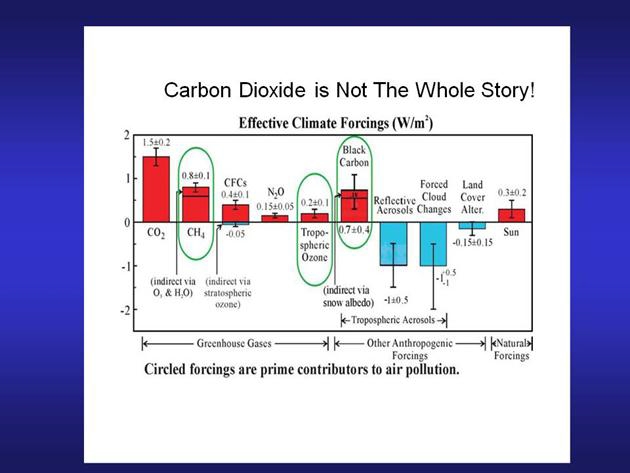 |
|||||
| 9 no 4, September, 2009, ISSN 1324-6011 Incorporating Lead Aware Times ( ISSN 1440-4966) and Lead Advisory Service News ( ISSN 1440-0561) The Journal of The LEAD (Lead Education and Abatement Design) Group Inc. Editor-in-Chief: Evan Whitton |
|||||
|
About Us
|
Lead abatement and greenhouse gas abatement go well together by Elizabeth O’Brien and Anne Roberts, The LEAD Group Inc.
Climate change is the most urgent issue facing us on the planet. Quite rightly, it’s attracting a mass of media attention, a great deal of talk, but not nearly enough action. In this newsletter article our intention is to claim some of the attention and part of the action, and press for more of the latter. How are the problems of lead poisoning, and the predicted changes in the world’s climate connected? Between the early 1920’s and 1986, leaded petrol was used in every country in the world. The global phase-out of lead from petrol will not only reduce exposure to lead poisoning, it will also reduce some contributors to global warming. (We are using the words “climate change” to cover the whole range of effects of global warming.) The production of greenhouse gases and the deforestation which worsens their effect never occurs without other forms of environmental mismanagement: toxic air pollution from combustion, loss of topsoils, massive creation of farm animal waste, etc. In this article, we will focus on the lead pollution which occurs as a result of combustion. Global warming has and will continue to have adverse effects on organisms already exposed to excessive lead levels. Exposure to lead will be increased during drought, floods, cyclones, wildfires and heatwaves, which are becoming more severe and frequent as a result of global warming. How will the global phase out of leaded petrol help slow the rate of climate change? The most important public health policy
in reducing global blood lead levels is the phase-out of lead from petrol;
unfortunately still incomplete. According to the United Nations, there are
fourteen countries [Ref: www.unep.org/PCFV/PCFVNewsletter/7GPM.html
] where leaded petrol is still sold for road vehicles. The UN has not
however recognized Kosovo as a separate country so, including Kosovo there
are fifteen countries with a total population of over a quarter of a
billion people, still selling leaded gasoline for road use. Making it mandatory to remove lead from petrol allows the use of catalytic converters. Only countries which have already banned leaded petrol are in a position to require the use of catalytic converters in all new motor vehicles sold. Black carbon, or soot emitted from vehicles and other sources, is a potent greenhouse gas Catalytic converters have undoubtedly reduced the amount of greenhouse gases including Black Carbon, coming from petrol engines, more than any other technology. For a country to be able to introduce vehicles with catalytic converters, it has had to phase out leaded petrol for road use. As far back as 1999, a news release by James Rochow, of The Alliance to End Childhood Lead Poisoning, following a meeting in Bonn, Germany, stated that the Health and Climate Change workshop “endorsed integrated solutions to climate change, including leaded gasoline phase-out. Integrated solutions must consist of measures that quickly and easily improve energy efficiency; help control Greenhouse Gases, both directly and indirectly; and achieve other pollution prevention benefits.” Rochow quoted Dr. Axel Friedrich, Director of the Environment and Transport Division of the German Federal Environment Agency: "Leaded gasoline phase-out is a perfect example of an integrated solution," said Dr. Axel Friedrich, "In addition to protecting millions of children and adults from lead's harmful effects, eliminating its use in gasoline is a first necessary step to controlling a host of other air pollutants, including greenhouse gases”… Rochow stated that lead makes it impossible to take advantage of modern technologies - such as fuel injection systems, on-board computers, oxygen sensors, and catalytic converters - that improve energy efficiency and reduce toxic vehicle emissions. At the 6th Global Partnership Meeting of the Cleaner Fuels and Vehicles Partnership (PCFV) of the United Nations Environment Program, in Beijing in May 2008, Michael P. Walsh and Elizabeth O’Brien had the following interaction, as recorded in Elizabeth’s personal minutes of the meeting: Michael Walsh (The International Council for Clean Transportation (ICCT)): PCFV is a climate change program, and all of PCFV’s activities are related to GHG [greenhouse gas] reduction. The ICCT met in Hong Kong recently, and recognized that clean fuels for vehicles are important in climate change. Transportation is a major contribution to GHG as defined by the Kyoto Protocol, which focuses on other contributors, but GHG from transportation is increasing everywhere, and most growth is expected in China, India, and the rest of Asia. The African countries are increasing their annual energy demand in the transport sector by 3-5%/year. We need to constrain global temperature increase to 2°C… It’s appropriate to see CO2 as the main contributor to GHG. Black carbon, tropospheric ozone, and methane combined are more important than CO2, and we can dramatically reduce these through clean fuels for vehicles. Black carbon is a significant component of particulates. Vehicles make a significant contribution to particulates. Black carbon travels far and damages ice caps at the poles… The reason black carbon hasn’t been included in the Kyoto Protocol is because its size and impact is contended. A unit of black carbon may be 2200 to 4500 times more potent than a unit of CO2. Black carbon intercepts direct and reflected sunlight… Vehicles are the principal source of methane and NOx which contribute to tropospheric ozone… We need low carbon fuels and to reduce VKT [vehicle kilometers traveled ie kilometers traveled per vehicle]. Elizabeth O’Brien: Michael, can you comment on the impacts of catalytic converters on GHG from transport? Michael Walsh: The 3-way catalytic converter dramatically reduces climate change. Elizabeth O’Brien: Then my recommendation is to speed the phase out of leaded petrol as a major contribution to climate change. [End of minutes] In his “Slide Presentation: Presented at the UNEP/OECD Meeting on Lead in Gasoline, 12-13 December, 1996 (Paris)”, Michael P. Walsh (see www.oecd.org/dataoecd/3/29/1944719.pdf ) lists: Lead In Gasoline Causes Serious Problems:
In his article “Ancillary Benefits for Climate Change Mitigation and Air Pollution Control in the World’s Motor Vehicle Fleets,” Michael P. Walsh begins by stating the case:“On-road motor vehicles, including cars, trucks, buses, and two and three wheelers, are a major source of urban air pollution and an increasingly important contributor to global anthropogenic carbon dioxide and other greenhouse gases. Great progress in reducing from gasoline-fueled cars emissions of urban air pollutants and their precursors has occurred in the major industrialized countries, and stringent requirements for diesel vehicles are starting to be phased in. However, the vehicle population and vehicle kilometers traveled are expected to continue to grow rapidly in the future, especially in developing countries, which will offset many of the gains to date”. Unfortunately, as Walsh seeks to identify, there are “areas in which strategies to reduce greenhouse gases (GHGs) conflict with strategies to reduce conventional pollutants or vice versa.” But he also seeks to “highlight strategies that can produce co-benefits resulting from both. Walsh lists three technology-based approaches to “reduce GHGs in the transportation sector: Setting mandatory or voluntary greenhouse emissions or fuel efficiency standards, shifting to lower-carbon fuels and advanced vehicle technologies, and reducing the use of motorized vehicles.” These are approaches which require legislation by national governments. Reducing the use of motorised vehicles requires provision of alternative methods of transportation and the planning of cities to reduce the need for long distance commuting. How black carbon contributes to global warming You are almost certainly familiar with the term “greenhouse gases”. What, on the other hand, is “Black Carbon”, and how does it contribute to global warming? According to WorldWatch Institute’s Glossary of 39 Key Terms for Understanding Climate Change”, on Black Carbon: "Some scientists believe that black carbon plays a large role in climate change and that reducing it may be one of the best opportunities to slow climate change in the short run." The following is from “Black Carbon: Playing a Major Role in Arctic Climate Change” by Rick Stegeman, published on June 12, 2008 in Articles, Arctic, Atmosphere & Space: “Black carbon - which is essentially the soot that results from the incomplete combustion of fossil fuels (petroleum, coal), biofuels, and biomass (wood, animal dung, etc.) - is the most potent climate-warming aerosol. The aerosol enters the atmosphere from automobiles (those with diesel engines being particularly high emitters), coal-fired power plants, wood stoves, kerosene lamps and forest fires. If produced continuously, and in large quantities, these can have a surprisingly large impact on climate, especially in the cryosphere. In fact, the latest research shows that black carbon is second only to carbon dioxide as far as major contributors to climate change. Soot produced by fossil fuels and biofuels combined may contribute to about 16% of gross global warming, according to Dr. Mark Jacobson, Civil and Environmental Engineer at Stanford University in California, one of the first climate modellers to integrate black carbon into the latest generation of climate models. “After being emitted, black carbon particles can remain suspended in the atmosphere anywhere from a week to four weeks before they are "washed out" and return to the earth via settling or precipitation. While suspended in the atmosphere, the presence of black carbon particles has a net warming effect. Unlike greenhouse gasses, which trap infrared radiation that is already in the earth's atmosphere, black carbon particles, being black, absorb all wavelengths of sunlight and then re-emit this energy to the surrounding environment as infrared radiation. As much as 30% of the warming in the Arctic is caused by black carbon in the snow “One place where black carbon particles can continue to have an impact once they reach the ground is in the cryosphere, particularly in the Arctic, which is polluted by black carbon aerosol transported through the atmosphere from its source, the highly-industrialised areas of the Northern Hemisphere. When pure, snow is very white and thus very effective at reflecting solar radiation from the earth's surface. If soot particles enter the snow, even in concentrations as small as ten parts per billion (which is undetectable to the unaided human eye), this reduces the snow's albedo, allowing it to absorb more solar radiation and allowing it to melt more readily. “Experts believe that black carbon has been responsible for significant warming in the Arctic. As much as 30% of the warming in the Arctic since pre-industrial times can be attributed to anthropogenic black carbon, according to Dr. Charles Zender of Earth System Modeling Facility at the University of California, Irvine, who is an expert in modelling atmospheric aerosol transport to the Arctic. During Arctic winters when there is little sunlight, the presence of dark soot particles in the snow doesn't make much difference. Only when solar radiation begins to increase rapidly in the spring and the melting season begins does black carbon have its greatest impact on snow cover. The presence of black carbon on the snow makes it absorb more solar radiation than it otherwise would, leading to more intense melting earlier in the spring. As snow and ice melt, this exposes darker, less reflective surfaces such as land and open water and creates a positive feedback situation which leads to accelerated melting, commonly referred to as snow-albedo feedback.” So why does Wikipedia say catalytic converters worsen climate change? The following information can be found on Wikipedia as at 22nd June 2009: Environmental impact Catalytic converters have proven to be reliable devices and have been successful in reducing noxious tailpipe emissions. However, they may have some adverse environmental impacts in use: The requirement for a rich burn engine to run at the stoichiometric point means it uses more fuel than a "lean burn" engine running at a mixture of 20:1 or less. This increases the amount of fossil fuel consumed and the carbon dioxide emissions of the vehicle. However, NOx control on lean burn engines is problematic and difficult. Although catalytic converters are effective at removing hydrocarbons and other harmful emissions, most of exhaust gas leaving the engine through a catalytic converter is carbon dioxide (CO2), one of the greenhouse gases indicated by the Intergovernmental Panel on Climate Change (IPCC) to be a "most likely" cause of global warming. Additionally, the U.S. Environmental Protection Agency (EPA) has stated catalytic converters are a significant and growing cause of global warming, due to their release of nitrous oxide (N2O), a greenhouse gas more than 300 times more potent than carbon dioxide. Michael P Walsh kindly sent the following graphic and made the following comments in response to this extract from Wikipedia: The impact of motor vehicles on climate change would be much worse without catalytic converters. These systems dramatically reduce carbon monoxide, hydrocarbons and nitrogen oxides from gasoline fueled vehicles and catalyzed particulate filters dramatically reduce particulate matter and black carbon from diesel vehicles. Reducing these pollutants has tremendous public health benefits as CO, Ozone (which results from HC and NOx in the presence of sunlight), PM (some of which is produced by secondary transformations of NOx) and N2O. With regard to climate, the impacts are almost all very positive.
Climate change forcing graph shows the impacts of various elements on global temperature. Courtesy of Michael P. Walsh. All combustion activities create both greenhouse gases and lead pollution The simple truth is: all combustion creates some lead pollution, because lead is ubiquitous in the environment. All combustion also creates a range of toxic air pollution, and combustion of solid fuels creates contaminated ash and other contaminated solid waste. Here we are only listing the leaded pollution from combustion. Lead occurs naturally in soils and rocks so the largest source of non-anthropogenic lead air pollution is volcanic activity. According to the San Diego State University Department of Geological Sciences: “Volcanic eruptions can enhance global warming by adding CO2 to the atmosphere. However, a far greater amount of CO2 is contributed to the atmosphere by human activities each year than by volcanic eruptions.” The same is true for lead from volcanoes. [Ref: www.geology.sdsu.edu/how_volcanoes_work/climate_effects.html] The combustion of leaded petrol / gasoline is regarded as the greatest source of planetary lead pollution (pollution of air, water bodies, ice, soils, sediments, building dusts, etc) ever! The addition of lead to petrol has been called “the mistake of the Twentieth Century”! [Ref: Carl M Shy, World Health Statistics Quarterly 43 (1990)].The combustion of unleaded petrol / gasoline also contributes a small amount of lead pollution because lead naturally occurs in crude oil and is thus found in trace amounts in all petroleum refinery products. Lead naturally occurs in wood to varying degrees depending on the particular species and the amount of lead in the soil. See Fine Particulates (PM2.5) Air Pollution Australia & Lead in Woodsmoke. Lead is emitted from all coal burning, including from coal-burning power stations. The CSIRO notes that: “[In Australian coal] Lead is present predominantly in pyrite and other sulfide minerals in bituminous coals. Occurrences of lead selenide have been reported. “[During combustion] Lead is volatile and condenses on the fly ash particles. It is enriched in the finer particles. A small percentage of these fine particles are emitted to the atmosphere from modern power stations.” [Ref: www.csiro.au/resources/Lead-In-Export-Coals.html - 3 June 2009] The CSIRO gives the concentration of lead in coal as: from less than 1 part per million (ppm) up to 22 ppm with an average of 7 ppm. Dr Karl Kruszelnicki notes: “On average, coal has 1.3 parts per million of uranium and 3.2 parts per million of thorium… These are very small quantities, but on the other hand a lot of coal gets burnt. “The world-wide use of coal in 1991 was about 5,100 million tonnes. When that coal was burnt, some 6,630 tonnes of uranium and 16,320 tonnes of thorium were released into the biosphere.” [Ref: www.lead.org.au/lanv5n3/lan5n3-8.html ] By extension, some 35,700 tonnes of lead would have been released in 1991 from coal-burning. But… “the rate of coal consumption is annually increasing at 2-3% per year” [Ref: http://en.wikipedia.org/wiki/Coal#Coal_as_a_traded_commodity ] Municipal and other wastes contain as much as 1% (10,000 ppm) lead which would mean in most countries it could be classified as a hazardous substance under occupational regulations, purely on the basis of its lead content, let alone other toxics. Incineration of municipal waste still occurs in many countries, including for electricity generation, thus presumably releasing many tonnes of lead and other toxics into the air or the bottom ash. Wikipedia tells us that “incineration of 1 ton of MSW [Municipal Solid Waste] produces approximately 1 ton of CO2. [Ref: http://en.wikipedia.org/wiki/Incineration#CO2 ] Getting more bang for your climate change abatement buck Even at very low levels, lead poisoning in children can cause developmental disabilities, hyperactivity, impaired growth, hearing loss, blood diseases, behaviour problems, reduced attention span, delinquency, criminal behaviour and decreased productivity. Effects on adults include high blood pressure, kidney disease, and impaired fertility. The almost completed phase out of leaded petrol has been the most important factor in reducing all these health effects. |
||||
|
About
Us |
bell
system lead poisoning |
Contact Us
| Council
LEAD Project | egroups | Library
- Fact Sheets | Home
Page | Media Releases Newsletters | Q & A | Referral lists | Reports | Site Map | Slide Shows - Films | Subscription | Useful Links | Search this Site |
|||||
| Privacy Policy | Disclaimer | |||||
|
Last
Updated 17 December 2011
Copyright © The LEAD Group Inc. 1991- 2011 PO Box 161 Summer Hill NSW 2130 Australia Phone: +61 2 9716 0014 |
|||||


